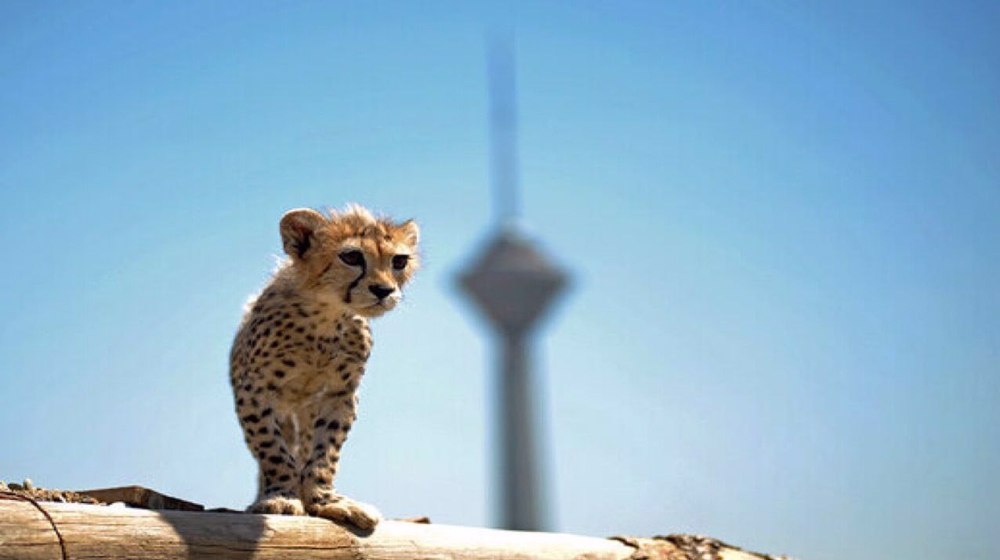Adieu 'Pirouz', Iran’s beloved captive-bred cheetah cub
By Maryam Qarehgozlou
The endangered Asiatic cheetah cub, Pirouz, born and raised in captivity in Tehran, died of acute kidney failure on Tuesday days before he would have turned 10 months old.
He died at the Central Veterinary Hospital in the Iranian capital after undergoing dialysis the previous night.
Pirouz's caretaker, Alireza Shahrdari, with moist eyes told reporters that taking care of the cheetah cub was challenging as the cub, delivered via C-section and not breastfed, faced various health complications.
Pirouz, which translates into “victorious” in Persian, was the last of two siblings born last May to “Iran” and “Firouz.”
“Iran,” the female Asiatic cheetah, with a high chance of pregnancy, was early last year transferred to a fenced area in the central part of the country where she mated with “Firouz”, a male cheetah.
The three cubs were the first to be born in captivity in Iran. Two of them died within the first two weeks of their birth but Pirouz managed to survive despite heavy odds.
Unfortunately, “Iran” refused to nurse her newly-born cubs.
In addition to breastfeeding, mothers lick their cubs’ bottoms to stimulate them to defecate and urinate, which Pirouz missed while in captivity.
Cheetah Conservation Fund, an international organization founded in Namibia in 1991 dedicated to saving the cheetah, says chronic kidney disease is commonly found in captive cheetahs.
It is still not scientifically known why captive cheetahs are more prone to this condition than their wild counterparts, but diet, age, genetic diversity, and chronic stress are cited as risk factors.
Pirouz had been previously diagnosed with gastrointestinal problems that persisted until his death.
Meanwhile, Amir Moradi, the head of the Central Veterinary Hospital, announced that “Iran” is most likely pregnant again and they are waiting for an ultrasound to confirm her pregnancy.
Cheetah conservations plans in Iran
The Asiatic cheetah (Acinonyx jubatus venaticus), slightly smaller and lighter than its African counterpart, is listed on the International Union for Conservation of Nature (IUCN) red list as critically endangered.
Iran is the last stronghold of the species fighting for survival.
The fastest land animal in the world is now only spotted in some habitats in Iran, mainly in the provinces of Semnan, Yazd, Kerman and Fars.
An UN-supported cheetah protection program began in Iran in 2001. Attempts for captive breeding started with a female cheetah Delbar, and Kushki, a male one.
In 2015, Delbar got pregnant naturally but sadly lost her cub. Kushki died in January due to old age.
The population of cheetahs is shrinking due to the combination of human and natural-driven threats.
Prolonged drought spells causing decreased prey species and habitat loss, road traffic accidents, and free-ranging domestic dogs threatening cheetahs as well as other predators through predation and transmission of diseases are factors driving cheetahs to the verge of extinction.
In January, Hassan Akbari, a deputy environment head, said that the Asiatic Cheetah population was down to just 12, from an estimated 100 in 2010.
However, some believe that due to poor surveillance in cheetah habitats, their population may be larger than announced.
In December 2022, two Asiatic cheetah cubs were found in Khar Touran National Park in central Iran's Semnan province.
Unfortunately, the two female cubs, “Azar” and “Touran,” separated from their mother at a very young age, and most probably cannot be reintroduced to the wild.
But their presence may indicate that the species are breeding in the wild more than already reported. They are not just properly traced and sighted.
Russia asks US to stop chasing Venezuela-linked oil tanker
UAE-allied separatists block Saudi delegation from visiting Yemen’s Aden
‘Be mindful of your soldiers’, Larijani warns US after Trump's post
Envoy says Iran strong, rejects 'crude falsehoods' of weakness as illusions
VIDEO | People pack General Soleimani’s resting place to mark his 6th martyrdom anniv.
VIDEO | Press TV's news headlines
General Soleimani — Master strategist who built the architecture of Axis of Resistance
Iran president hails ‘’heroic Cuban people’ on anniversary of revolution










 This makes it easy to access the Press TV website
This makes it easy to access the Press TV website